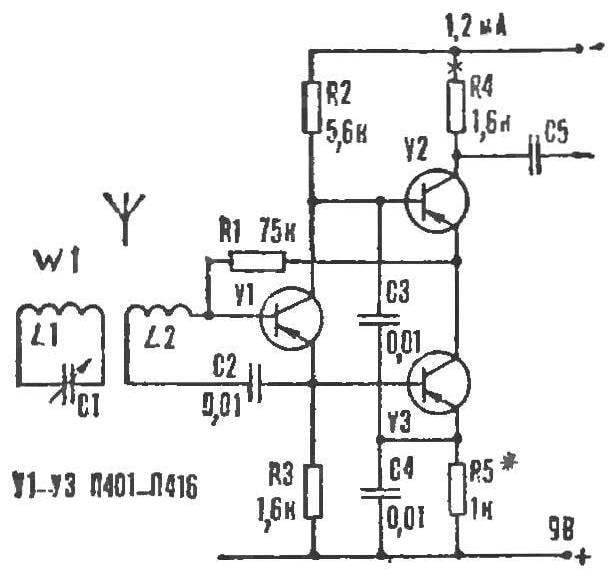The volume of the radio will increase, if it is to apply a high frequency amplifier, assembled by one of the schemes shown in figure 8 A—D.
In a reflex receiver 5 transistors (Fig. 9) performed on the UHF high-frequency transistors V1, V2. They are also used as a preliminary low-frequency amplifier.
Amplifier power LF — a push-pull, transformerless. Output power is 100 mW, the current “silence” — 6 mA.
The transformer T1 is wound on a ferrite ring brand 600НН Ø 8 — 10 mm or trimming the stem of the same brand size 2,8X16 mm. Coil 1 has 35 turns of wire sew 0,13—0,15 and the secondary is 100 turns of PEV of 0.12.
To design suitable items from a set of radio Yunost: transistors, capacitors, ferrite rod, magnetic antenna, RF transformer housing.
After installation using the resistor R10 set the collector current of transistor V8 in the range of 3-4 mA, and through R6 are selected, the collector current of V2 is equal to 0.9—1.2 mA. The potential at point A equal to half the supply voltage, install a resistor R7.
Radio diagram is in figure 10, is powered by a source of low voltage (4.5 V). The low-frequency amplifier — four stage, with direct coupling between transistors. In a preliminary low-frequency amplifier (V5, V6) to stabilize the operation of transistors in DC introduced negative” feedback resistors R8, R10, R12. In addition, negative feedback amplifier, covered with output to the emitter V5 through a resistor R17.
Symmetrical output stages of a power amplifier made on transistors of different structures are included in the circuit with common emitter.
Despite the relatively large number of transistors, the receiver is very economical and easy to establish.
Output power 100 mW, current in silent mode and 5.5 mA.
Fig. 7. Wiring diagram of the capsule DEM-4m.
Fig. 8. Options (A—D) schematic of the amplifier high frequency.
Fig. 9. Scheme of reflex radio:
V1, V2 П401 – П416; V5 MP35 — MP38; V6, V8 МП39 – МП42; V3, V4, V7, Д9Б, Д9Д, Д9Е.
Fig. 10. The receiver circuit with a reduced voltage:
V1, V2 П401 — П416, V5, V6, V8, V11 МП39 — МП42; V9, V10 MP35 — MP38; V3, V4, V7 D9 with any alphabetic index.
Fig. 11. Diagram of UHF to the receiver with low voltage.
Establishing device is to install with a resistor R12 of the current output stage of NCH within 3 mA; the voltage at the midpoint of the output stage equal to half the EMF of the battery, select the resistor R11; a change in the value of the resistor R5, the collector current of transistor V2 is doing is equal to 1 mA.
If the amplifier high frequency radio to improve, adding another cascade, the requirements for the selection of high-frequency transistors in this case are less rigid (Fig. 11). Emitter-follower V2 improves the performance of the amplifier as a whole and allows the use of transistors with low gain. UHF is operable even if all of the semiconductor triode will have = 10. Moreover, the transistor with the lowest gain should be used as VЗ and greatest — V2.
The amplifier requires little or no networking. If necessary, the collector current of V3 is set by selection of resistor R7.
In radio you can apply capacitors KLS, K10-7, KDK, K10-23; electrolytic K50-3, K50-6, K50-12, K50-16; diode D9 with any alphabetic index. For magnetic antennas need territoay rod length of 100-120 mm, brand with permeability of 400— 600 HH.
Coil L1 has 180-200 turns of wire of PEL or PEV of 0,1—0,13, L2—7—12 turns of the same wire Ø 0,12—0,18 mm. coil Winding — single layer, turn to turn, in paper frames.
To configure the radios only need with “fresh” battery. This will ensure the proper setting of the operating mode of the transistors. In the process of establishing the connection coil L2 with the ferrite rod removed.
V. MALESHEVSKI
 First steps in radio, many often begin with independent fabrication of a transistor radio. Along the way, introduces the electronic components, acquired the skills in installation and work with measuring devices. And achieve rapid practical results is to the same positive stimulus for further study of fundamentals of electronics, gives confidence in their abilities and capabilities.
First steps in radio, many often begin with independent fabrication of a transistor radio. Along the way, introduces the electronic components, acquired the skills in installation and work with measuring devices. And achieve rapid practical results is to the same positive stimulus for further study of fundamentals of electronics, gives confidence in their abilities and capabilities.
